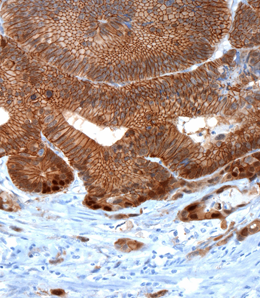Why tumor cells leave home

(Medical Xpress)—Malignant cells can escape from primary tumors and colonize new sites in other tissues. In a new study, LMU researchers show how the transcription factor AP4 promotes the development of such metastatic tumors.
Cell growth and cell division are markedly promoted by a master regulator called c-MYC, which functions as a transcription factor. The c-MYC protein is essential for all processes that require vigorous cell proliferation, such as embryonic development and hematopoiesis, and its function is normally kept under tight control. Indeed, failure of these control mechanisms can result in uninhibited cell proliferation – and the formation of tumors. This is underlined by the fact that levels of c-MYC are found to be abnormally high in about half of all human cancers.
The question of how c-MYC actually contributes to tumorigenesis is a major focus of research underway in Professor Heiko Hermeking's laboratory at LMU. In a new study, he and his group have identified a further strand in the web of interactions governed by c-MYC. "In an earlier study, we had found that c-MYC induces expression of the transcription factor AP4. But as it was not known precisely which genes are regulated by the latter, it remained unclear which of c-MYC's effects are mediated by AP4," Hermeking explains.
With the aid of genome-wide characterization of AP4's target genes and direct functional tests, Hermeking's team have now carried out a systematic investigation of the actions of AP4 in the cell, and uncovered processes relevant to tumorigenesis and cancer progression that are triggered by the protein.
Their most important finding is that AP4 plays an important role in facilitating the formation of metastases. Metastases are secondary tumors that become established when malignant cells migrate from the primary tumor to other, often distant, tissues, and continue to proliferate there. "It turns out that AP4 initiates this process: It transforms locally proliferating, non-aggressive tumor cells into invasive metastasizing cells by inducing the so-called Epithelial-Mesenchymal Transition (EMT)," Hermeking explains. Reversible EMTs are a normal component of development. The term refers to a process in which adhesive cells growing in an ordered sheet on an underlying layer of connective tissue acquire the ability to dissociate themselves from their neighbors and penetrate through a so-called "basement membrane". Such cells are then free to migrate to other tissues, where they may either regain their epithelial character (during normal development) or, in the case of malignant cells, seed the formation of new tumors.
The new findings are of considerable clinical relevance. The researchers have shown that colon cancer patients whose tumor cells produced AP4 in large amounts were significantly more likely to develop metastases in the liver after surgical removal of the primary tumor, and had a poorer prognosis, than patients with lower levels of the transcription factor. "Conversely, we found that a specific pharmacological inhibitor of AP4 prevented the formation of metastases in a mouse model," Hermeking adds. Hence, these results indicate that AP4 is not only of diagnostic and prognostic value, but also represents a promising target for therapeutic interventions. The LMU team now plans to identify further targets of AP4 in tumor cells and determine whether other regulatory molecules, apart from c-MYC, act on the protein.
More information: JEM 2013: jem.rupress.org/content/early/ … 3/06/04/jem.20120812

















